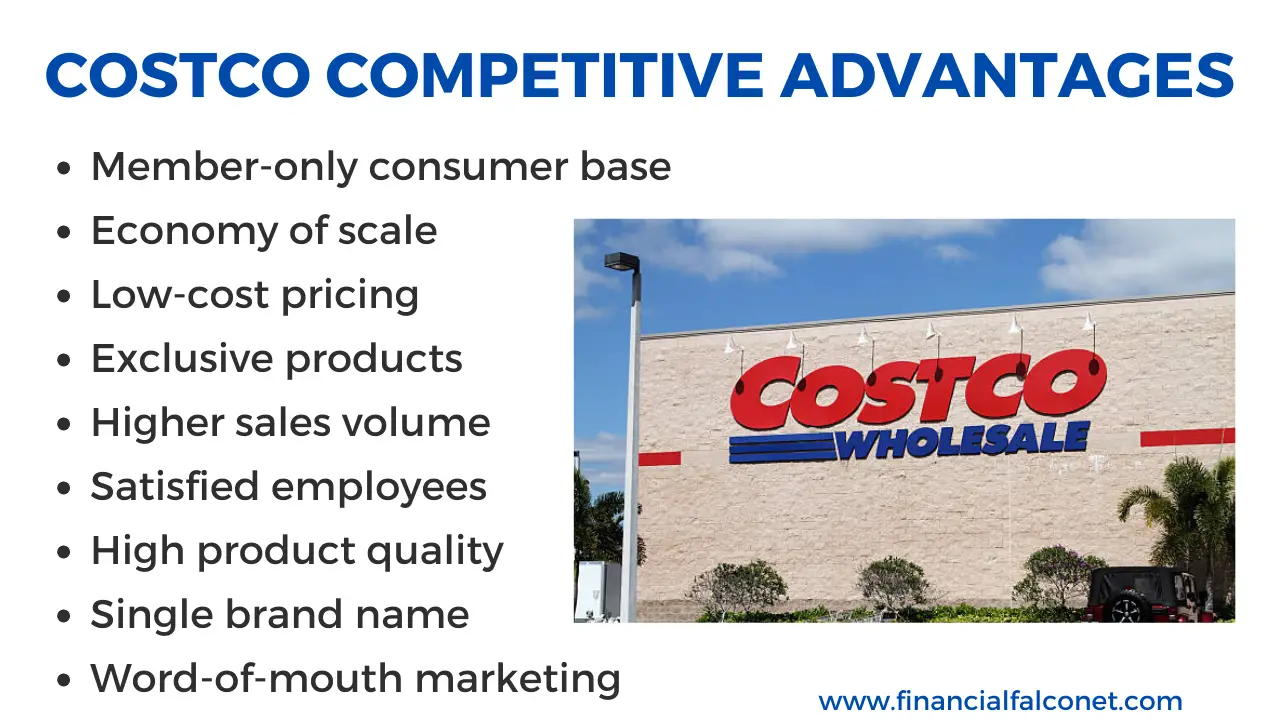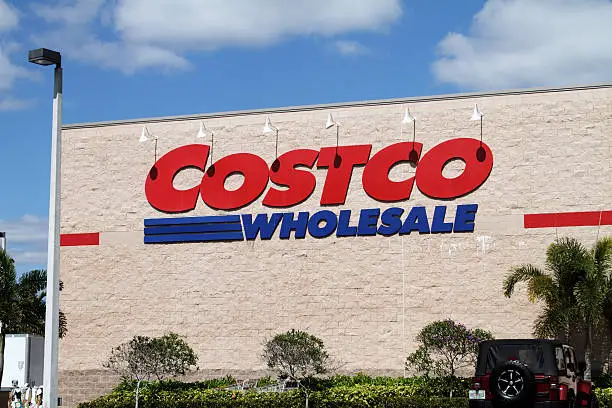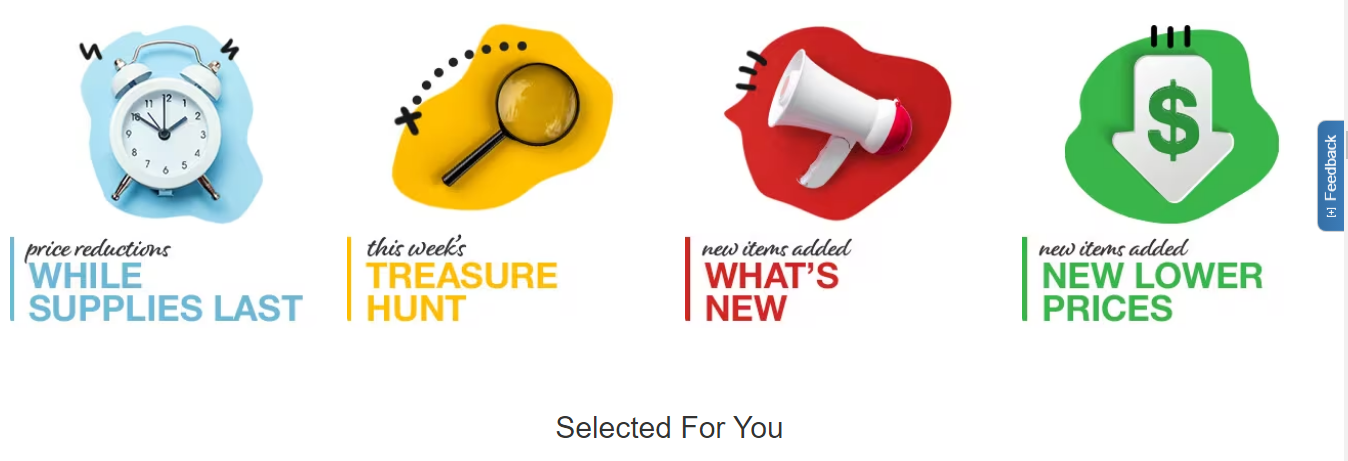Costco’s competitive advantage of low-priced and high-quality products is influenced by its competitive strategy of cost leadership and product differentiation.
The company traces its origin back to the establishment of the first wholesale club, Price Club by Sol Price in 1976 in San Diego, California. This was a novel retail concept as it employed the use of member-only access to its warehouses.
Initially, only small business owners could shop at this wholesale club as it was meant to provide cheaper goods for these businesses that operated smaller retail stores on campuses, districts, and street corners.
However, in a bid to serve a wider customer base, the membership was gradually expanded to include individual shoppers provided they were registered members of the wholesale club.
It was based on this concept of members-only that the first Costco wholesale club was established in Seattle, Washington in 1983 through a partnership between Jim Sinegal and Jeff Brotman.
In 1993, these two wholesale clubs merged together to expand their market share and increase their capacity to provide better quality products at lower prices to their teeming membership.
Due to Costco’s effective supply chain management, the company has continued to grow. As of August 2023, the brand has 861 warehouses scattered across 14 countries with 124.7 million cardholders including 69.1 million households. The brand employs 304,000 full and part-time workers.
Costco is the 5th largest retailer in the world based on a business valuation done by Kantar Group in 2023. The brand’s revenue for the 2022 fiscal year was $222.7 billion. This huge revenue has placed it as the world’s largest warehouse club in the same year.
The brand’s private label, Kirkland Signature which was introduced in 1995 is among the top contributors to Costco’s competitive advantage. Through this brand, the company offers a wide category of exclusive products to its members at competitive prices.
Here, we shall discuss Costco’s competitive advantages as well as the strategies that it employs to maintain its position as a leader in the warehouse club business and a top contender in the retail industry.
Read about: Target’s Competitive Advantage and Strategy

Who are Costco’s competitors?
Costco’s competitors typically comprise companies that operate based on the warehouse club model such as Sam’s Club, BJ’s Wholesale Club, City Club, Carrefour, Metro AG, and PriceSmart.
Additional competitors are global retailers and local grocery stores that operate in the same geographical locations as Costco. Some of these competitors include Walmart, Tesco, Coles, Aldi, Amazon, Target, Meijer, Kroger, and Schwarz Group.
Read about: Starbucks’ Competitive Advantage and Strategy
What makes Costco different from its competitors?
Costco is different from other global retailers because it is open only to members. This means that without a membership registration, one cannot shop at the company’s warehouses. An additional thing that makes the brand different from its competitors is the exclusive product ranges that can only be found at the wholesale club.
The brand’s ability to meet the needs of both small business owners as well as individual shoppers is also another differentiator between Costco and its competitors. This is because most of the company’s competitors serve only individual shoppers.

Read about: Nike’s Competitive Advantage and Strategy
Costco competitive strategies
- Cost leadership
- Differentiation strategy
- Focus strategy
Costco’s Cost Leadership Strategy
A major competitive strategy of Costco is its laser focus on cost leadership. This strategy refers to the company’s ability to offer products to its consumers at a lower price when compared to its competitors.
Costco is able to offer low prices for its products due to a combination of its lean overhead cost, active involvement in its supply chain process, and large purchasing power.
The lower product price gives Costco a competitive advantage because consumers gain a price value since they can buy more products for less money. As captured on the company’s website:
Our operating philosophy has been simple. Keep costs down and pass the savings on to our members.
Costco
Differentiation strategy
Business corporations that use the differentiation strategy focus on creating better and distinct products or services than what is already obtainable in the market.
This can be achieved through regular and consistent research and development of new products or the improvement of existing ones. It can also be achieved through creativity and innovation such that competitors do not gain the ability to replicate the product or service.
Costco partially uses the differentiation competitive strategy through its manufacturing of special food packaging and its operation of optical laboratories and meat processing facilities. It also uses it in its jewelry distribution initiative.
The brand’s products, which are manufactured exclusively for its private brand are the differentiators. All products under this private brand can only be accessed at the company’s warehouses.
Due to Costco’s differentiation competitive strategy, the company was recognized as the world’s largest retailer of organic foods, choice and prime beef, wine, and rotisserie chicken in 2016.
Focus strategy
Focus is another intrinsic part of Costco’s competitive strategy. This strategy involves curating a brand’s products or services to serve a particular consumer demographic. It is achieved by focusing on a specific need of the targeted consumer base and meeting it through the products or services offered by a company.
Costco implements the focus competitive strategy by offering its exclusive products only to a limited consumer base, its warehouse club members. By doing so, the brand has reduced undue competition from other retailers who are open to a wider consumer base.
In addition to focusing on a particular niche through the focus differentiation strategy, a company could also implement the cost leadership strategy, the differentiation competitive strategy, or both. This is because combining at least two or all three competitive strategies ensures better outcomes for a business.
Costco’s competitive strategy utilizes all three competitive strategies and has brought about considerable competitive advantages for Costco in its operation within the retail industry.
Read about: Tesla’s Competitive Advantage and Strategy
What competitive strategy does Costco use?
Costco uses a combination of competitive strategies including cost leadership, product differentiation, and focus competitive strategies. Each of these strategies offers a unique competitive advantage to the company.
Through cost leadership, the brand minimizes its overhead costs, thereby being able to offer cheaper products to its patrons.
The differentiation strategy enables Costco to offer exclusive products that cannot be gotten at other retail stores.
Its focus competitive strategy ensures that only Costco Wholesale club members are its target consumer base.
These combined competitive strategies are used by Costco to strengthen the brand’s position as the world’s largest warehouse club.
Read about: McDonald’s Competitive Advantage
Costco competitive advantages
- Member-only consumer base
- Economy of scale
- Low-cost pricing
- Exclusive products
- Higher sales volume
- Satisfied employees
- High product quality
- Word-of-mouth marketing
- Single brand name
Member-only consumer base
Operating a member-only consumer base is one of Costco’s competitive advantages. Unlike other retail stores that are dependent on individuals randomly coming to their outlets to shop or on their website, the members-only concept of Costco is a focused competitive strategy that has allowed the business to niche down its operation toward a particular market demography.
Without a membership card, individuals or small business owners cannot shop at the wholesale club. This has led to the creation of a steady means of recurring income for the brand through membership subscriptions.
It has also generated a consistent and loyal customer base as a large percentage of the customers renew their membership annually. At the end of the fiscal year 2022, Costco reported a 90% membership renewal rate worldwide and a 93% renewal rate in Canada and the United States.
More individuals also sign up in order to enjoy the benefits of being a member of the wholesale club. The brand offers 2 different membership options to businesses and individuals.
Small business owners that run campus stores and other small retail stores can register either as Business executives or Business members. These business membership offers additional services to its members such as the delivery of products, access to payment processing, and business health insurance.
Individuals can sign up as Gold Star members for a fee of $60 or as Executive members for $120. Executive members enjoy additional perks such as the ability to earn up to 2% rewards on qualified Costco travel purchases.
The membership model of Costco ensures consistency in patronage as well as consumer loyalty. As of August 2023, the wholesale club boasts about 124.7 million registered members.
Economy of scale
Being the fifth largest retailer in the world in 2023 means that Costco purchases a significant amount of products from the various manufacturers and companies whose products are available at the warehouse club.
Costco’s tremendous buying power means that it can negotiate better prices with manufacturers and product suppliers. This is because the companies they do business with will not want to lose their patronage due to the large products they purchase consistently.
As a result of this, the brand is generally able to purchase its inventory at a cheaper rate when compared with other businesses that do not have as much purchasing power. Hence, economies of scale is part of Costco’s competitive advantages.
Low-cost pricing
One distinguishing feature that offers a huge competitive advantage to Costco over other retailers is its low-cost pricing. The company’s active involvement in its supply chain process is one of the contributors to its low pricing.
By producing some of the products sold under the Kirkland Signature through the Costco wholesale industries and its direct partnership with other manufacturers for the production of certain items, the company is able to reduce the overall cost of products.
Costco usually transacts directly with its product manufacturers and is actively involved in every step of the supply chain process. The company’s active involvement enables it to effectively eliminate virtually all the frills that cost extra spending.
For instance, they directly contract companies such as XPO Logistics, Rapid Express Freight, and Averitt Express to take care of their inbound and outbound logistics. This enables them to negotiate cheaper transportation rates especially due to the large volume of goods they transport through these freight companies.
Additionally, the company’s never-ending quest for efficiency in its operations through its implementation of a lean budget with only 10% or less of its total revenue being spent on overhead costs is also beneficial to Costco’s competitive advantage. This is made possible by the elimination of third-party involvement and the implementation of the no-touch policy in its supply chain.
The no-touch policy ensures that products are efficiently moved through the supply chain with minimal human contact. This means that most products that are sold at Costco warehouses are not repackaged, instead, manufacturers follow stringent packaging standards to ensure the products can be sold directly to consumers from the pallets they were originally packaged in.
Another factor that enables Costco’s competitive advantage of offering low prices to consumers is that the business is not wholly making large sums of profits from the sale of products. Instead, it implements the cost-plus pricing strategy to ensure that the cost of production or product purchase is covered and a little profit is made.
Costco makes a profit of between 14-15% on the brands it sells as well as from its private brand, Kirkland Signature. This relatively low cost-plus percentage ensures that the prices of goods at Costco warehouses are considerably cheaper when compared to other retailers.
For example, Costco sells the 174 count size 4 Huggies diaper for $52.49 while other retailers like Amazon sell the same for $64.95 as of September 2023. Hence, the low pricing of products constitutes a competitive advantage for Costco.
Exclusive products
Costco’s competitive advantage also includes the exclusive products the brand offers. Most retail stores in the United States such as Walmart and Kroger sell similar items and even carry products from the same manufacturers. Costco however has distinguished itself by offering exclusive products to its members, especially through its private brand.

In most instances, Costco is able to achieve this by entering into exclusive contracts with product manufacturers that make the products but under the company’s private label name which makes Costco the exclusive retailer of these products.
The company also makes seasonal offers of certain products especially fresh produce like chestnuts, blueberries, apples, celery, and grapes. These exclusive partnerships and offers keep customers coming back to the warehouse because they cannot access these products anywhere else.
Higher sales volume
Part of the foundational principles of Costco is the bulk packaging and sale of products; this ensures that they sell more products than other retailers which is another competitive advantage for Costco.
For instance, while you can buy a single toothpaste at other retail stores, you can only buy 5 of the same toothpaste if you are shopping at Costco. This is because, unlike other retailers that display single products in their stores, Costco warehouses have products displayed in bundles of 3, 5, 10, or more.
The bulk packaging ensures that consumers make a more significant purchase whenever they shop. It also gives consumers a sense of buying more products for less money when compared to buying single products.

The higher volume of purchases directly translates to higher sales and higher revenue for the company in the long run. This is a pivotal contributor to Costco’s competitive strategy of cost leadership.
Hence, despite the low pricing of products, the high volume of sales gives Costco a competitive advantage over other retailers as it is able to make considerable sales which accumulate to a considerable profit. It also ensures that the company has adequate working capital at a time.
Satisfied employees
One of Costco’s top achievements and most significant strength is perhaps its satisfied workforce. As far back as October 2021, the company increased its minimum wage to $17 an hour. This remains one of the highest hourly rates in the retail industry.
The company also offers other significant perks and benefits to its employees, such as full health and dental insurance. It is therefore normal that the brand has often been praised for providing its employees with higher pay and better benefits than were customary in the field of retailing.
The company provides such beneficial employment perks due to its culture of doing the right thing which entails obeying the law, taking care of its members and employees, and respecting its suppliers.
In 2023, the brand ranked No. 3 in the retail and wholesale category of the list of Forbes’ America’s Best Large Employers and No. 25 in the general category. The ranking was based on the willingness of a company’s employees to recommend their current employers to friends and family.
This shows that the company’s employees are satisfied with working for the brand, thus, its satisfied workforce is another competitive advantage that Costco has.
The satisfied workforce additionally translates to effective customer service. Since the employees enjoy their work, they serve consumers better, hence giving them a wholesome consumer experience every time they patronize Costco.
High product quality
Costco has positioned itself as a provider of premium products at affordable prices, generally through all the products it sells and especially through its Kirkland Signature products. This enhances the appeal of the wholesale club across small business owners as well as individuals.
A clear example of the high-quality products sold at Costco can be seen in its partnership with the premium coffee producer, Starbucks. Through this partnership, the wholesale club offers a variety of high-quality coffee including the House Blend Medium Roast and the Espresso Blend Dark Roast. These coffee blends are custom-made by Starbucks but under the Kirkland Signature brand name.
Product quality has been an integral competitive advantage for Costco because it is a significant contributor to the brand’s growth as it keeps driving and maintaining consumer loyalty.
The company’s stock of high-quality products gives its members a sense of getting a great deal on the money for shopping at and being loyal to Costco.
One of the ways Costco has maintained a high product quality is through the limited products it carries. For instance, while other supercentres carry as many as 142,000 stock-keeping units (SKUs), Costco has always maintained its SKUs at or below 4,000. The limited SKUs enable the warehouse club to enforce stringent quality checks on the products they offer consumers.
Due to the limited SKUs, each product gains more perceived value. It also aids in narrowing down the choices available to consumers so that they do not suffer from choice paralysis whenever they need to shop at the warehouse.
Word-of-mouth marketing
While other retailers spend a considerable sum annually on a variety of marketing options including TV, social media, SMS, and email marketing, Costco has been dependent on a marketing option that involves zero marketing budget which is word-of-mouth marketing.
Due to the high value Costco places on keeping a lean overhead cost, it does not run promotional and other marketing campaigns for its warehouses and products, instead, it depends on its consumers and employees to talk about the brand and encourage more people to patronize the brand.
Over the years, this has proven to be an effective marketing strategy because it saves the company money and also ensures that the brand provides top-notch customer service and high-quality products in a bid to keep consumers talking about the many benefits of becoming a member of the wholesale club.
Hence, in this digital and highly competitive era, running a profitable business without spending money on marketing is a remarkable competitive advantage that Costco has among a large percentage of businesses in existence today.
Single brand name
Whenever you visit a grocery store, you are going to be confronted with a large variety of brand names for different product categories. Therefore, having only one brand name for a wide variety of products is another Costco competitive advantage.
Costco offers a wide category of products including pet food and supplies, health and beauty, baby care, household and kitchen, clothing, grocery, and organic products but all under the Kirkland Signature brand.
Having a single brand name for this varied category of products has aided in easier remembrance and recognition of the products made by or for Costco. This in turn makes it easier for consumers to identify products from the company.
Read about: Subway’s Positioning and Marketing Strategies
What is Costco’s competitive advantage?
Costco’s main competitive advantage is the low pricing of its products and its high quality. Other competitive advantages of Costco include a member-only consumer base, economy of scale, and exclusive products.
Additional competitive advantages of Costco include high sales volume, satisfied employees, word-of-mouth marketing, and a single brand name for a wide category of products.
Overall, these Costco competitive advantages have set the brand in a class of its own making it the most successful warehouse club in the world.
Read about: Lululemon Marketing Strategies and Marketing Mix
Last Updated on November 2, 2023 by Nansel Nanzip BongdapBlessing's experience lies in business, finance, literature, and marketing. She enjoys writing or editing in these fields, reflecting her experiences and expertise in all the content that she writes.
